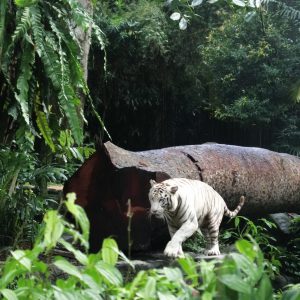The History of Singapore’s Wild Tigers
August 1, 2022

The Wildlife Reserves Singapore (WRS) was formed on 1 August 2000, bringing together Singapore Zoological Gardens, Jurong Bird Park, and Night Safari. This merger paved the way for greater effectiveness in conserving biodiversity in the country, in collaboration with other Southeast Asian organisations and institutions, through self-funded initiatives. Even though the WRS celebrates and inspires the protection of wildlife today, there was a time in Singapore’s history where wildlife was considered a threat to be eliminated.
In 1831, the first newspaper report of tiger sightings in Singapore was released. Though it is hard to imagine tigers prowling in the cityscape today, they lived rather freely in colonial Singapore. Associate Professor Timothy P. Barnard (NUS Department of History) and Dr Mark Emmanuel acquaint us with this history of tigers in “Tigers of Colonial Singapore” (Nature Contained, 2014).
As agricultural expansion pushed back forest boundaries, plantation workers became exposed to wild tigers in the 19th century. Originating from the Malay Peninsula, these Malayan tigers swam to Singapore, claiming their first reported victim in September 1831. A startling 200 deaths from tiger attacks were estimated in 1850, in a population of just 50,000 people. Agricultural settlements grew tremendously as gambier and pepper were key exports of the country, leading to immense deforestation, which caused more tiger attacks.
To safeguard the plantation workers and the economy, reward systems for the capturing and killing of tigers were introduced. In a time where plantation owners earned an average of $350 a year, the colonial government offered rewards of up to $100 for eliminating tigers. Hunters could turn a profit from selling the tigers’ hides as well. The Western elite established a “Tiger Club” to recreationally hunt for tigers, giving hefty rewards to plantation owners who allowed them to kill tigers on their properties.
After the 1850s, tiger attacks went down a lot, and tigers were viewed more as entertainment than a threat. Tigers would be exported from Singapore to countries like Australia, and plantation owners would keep captured tigers alive for viewing. The Singapore Botanical Gardens even exhibited a tiger and a leopard in the 1870s. Where tigers were once a menace to the island, they are now commemorated as part of its cultural heritage. The last wild tiger was killed in 1930 in Choa Chu Kang, marking the end of a century-long history of Singapore’s tigers.
Read the full chapter here.

What a fascinating piece of history! I loved learning how wild tigers once roamed colonial Singapore and played such a significant role in the island’s early encounter with settlement and agriculture — from documented sightings in the 1830s to the intense human–tiger conflicts that led colonial authorities and locals to hunt them extensively. The way the article connects environWhat a fascinating piece of history! I loved learning how wild tigers once roamed colonial Singapore and played such a significant role in the island’s early encounter with settlement and agriculture — from documented sightings in the 1830s to the intense human–tiger conflicts that led colonial authorities and locals to hunt them extensively. The way the article connects environmental change, economic expansion, and cultural perceptions really brings this lost chapter of Singapore’s natural past to life. Thanks for sharing such an engaging and informative look at how Singapore’s landscape and wildlife have transformed over time! mental change, economic expansion, and cultural perceptions really brings this lost chapter of Singapore’s natural past to life. Thanks for sharing such an engaging and informative look at how Singapore’s landscape and wildlife have transformed over time!